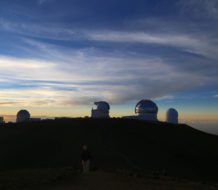No, but it may be an important component. Imagine trying to spend a week without any information. No books or broadcasts, no entertainment or news. No communication with another person, whether written or spoken or visual or just touching. It would be a diminished kind of existence. That is why extended solitary confinement is such a terrible punishment. Information plays a vital role in everyday human life. But to what extent is information the basis of reality?
The significance of a communication cannot be measured by the amount of information contained in it. It takes the same number of words to say “Thank you for tea” as to say “Will you marry me?”, but they may have vastly different consequences. On 18 April 1775 Robert Newman and his friend Captain John Pulling climbed the steeple of the North Church in Boston Massachusetts with two lanterns. This was a one bit message, encoded as “one if by land and two if by sea”. The lanterns were displayed for less than a minute, but this was sufficient to inform the patriots in Charlestown about the movements of the British army. A rider was dispatched to Lexington, though he never arrived and his name is lost. The message was spread by others, as immortalized in Longfellow’s poem Paul Revere’s Ride. A single bit of information had decisive significance.
In the industrial revolution, concepts of energy were crucial for building and optimising engines. A Big Question at the time might have been, “Is energy the basis of reality?” Alongside the understanding of energy there grew an explanation of the behaviour of gases in terms of the motion of molecules. In principle, if you knew at some instant the position and momentum of each molecule, then you would be able to predict the behaviour of the gas ever after. But the number of molecules is very large (6 × 10 23) in every 22.4 litres at standard temperature and pressure). Even with advanced computers it would be impractical to keep track of all of them. Instead scientists used statistical concepts to describe the behaviour of gases. The success of these methods convinced skeptics of the reality of molecules long before they could be seen by modern methods of microscopy. The thermodynamic concept of entropy in statistical mechanics is closely related to information.
If in the nineteenth century technological progress was driven by mechanical engines, then the twentieth century it was driven by communication and computation. In 1948 Claude Shannon published A Mathematical Theory of Communication. He formulated a theorem of source coding, which states how many bits are needed to specify an uncertain event, and of channel coding, which shows how reliable communication is possible even in the presence of random noise. This description does not depend on the significance of the message. But it gives mathematical rigor to communication, and is used by every electrical engineer designing systems for information technology. Because of the similarity of the equations to those of statistical mechanics, terms from thermodynamics such as entropy have entered the vocabulary of information engineering.
Meanwhile biologists have been discovering the value of information as a concept. Information may become even more important than evolution in some rapidly developing areas of research in the life sciences. Consider DNA: when Crick and Watson determined its structure they announced in the local pub that they had found the secret of life, though James Watson later reflected that this may have been too strong a claim. Their work revealed the mechanism whereby living organisms encode and transmit genetic information. No biologist would assert that DNA provides a self-contained set of instructions; the growth of living systems is much more subtle than that. Epigenetics studies the crucial interplay between the encoded information and the environment, and how information management plays a central role in generating biological organisation.
Classical information comes in bits; this is how the computer on which you may be reading this essay works. This year, 2012, marks the centenary of the birth of Alan Turing, who formulated the concept of a universal computing machine. In 1985 David Deutsch published an analysis of the Turing machine in what became a manifesto for quantum computing. Quantum computers will be fundamentally different from classical computers. Whereas classical bits are each either a 0 or a 1, superposition allows quantum bits to be both 0 and 1 at the same time, making possible computational operations which would be impossible in CMOS logic circuits. Entanglement extends this to allow two quantum bits to be correlated beyond anything that can be explained in terms of classical intuition, giving quantum computing exponential potential for certain applications. Remarkable progress is being made in laboratory scale quantum computers. Many of the key components have been demonstrated in optical circuits, ions trapped in a vacuum, superconducting circuits, and in electron and nuclear spins in gallium arsenide, silicon, molecules, and diamond. It will be exciting to see which of these, and in what combination, will eventually form the heart of industrial production of quantum computers.
Alongside the remarkable development of quantum technologies, quantum information has raised fresh questions about the nature of reality. In the nineteenth century, science seemed to describe a reality which is objectively there regardless of any observations. Quantum mechanics brought all this into question; since the early days it has been an open question whether quantum states are states of fact or states of knowledge. Albert Einstein wanted science to describe what is actually the case, and was frustrated that quantum mechanics seemed to be incomplete. Neils Bohr argued that science was restricted to what we could say about an experiment and its probable outcome. In 1985, the same year that David Deutsch published his seminal paper about the universal quantum computer, Tony Leggett and Anupam Garg published a test which would allow an experimenter to determine whether an experiment was consistent with a classical macrorealism which they were careful to define. Part of their motivation was to address the apparent inconsistency between the quantum description of atoms and the classical experience of our us-sized everyday lives. More than twenty five years later, experiments have been performed which establish a methodology for implementing their test, and which experimentally rule out a certain kind of realism at the atomic scale. Related experiments have shown cases where measurements must have disturbed the quantum state even though their effect cannot be detected. Some realist interpretations of quantum states could never be ruled out by any experimental results consistent with quantum theory, but there is growing proof that wholly statistical interpretations are not tenable.
Rapid progress is being made in explaining how information is processed by the brain, and this may contribute to a deeper understanding of the relationship between myself and my body. The information that is integral to my experience and my memories contributes crucially to being me. One of the biggest questions anyone can ask is what happens after I die? Answers range from annihilation to reincarnation or some nirvana-like state. For those who have confidence in the evidence of the resurrection, the concept of information may offer insights into how the self endures. It will not be in the same body, which decays following death, but neither will it be disembodied. In some way information may give continuity to the reality of a person after death.
Within the foreseeable future information may become as fundamental a concept in the natural sciences as, say, energy, though it is too early to say what form this generalisation might take. There is no law of conservation of information comparable to the conservation of energy, which is why intelligent design arguments based on information do not work, and there is no equation relating information to mass. But information as a basic category of scientific thought seems to be ripe for development, and as that happens new insight may be gained into how it is a component of the nature of reality. In so far as reality has to be understood relationally, the flow of information may play a crucial role. But we need to learn much more about the nature of information and its physical instantiation before we can say how it contributes to the basis of reality.
Most of this essay has been about information. Reality is fairly widely understood as the way the world is, irrespective of what we might think it to be. Leaving aside for a moment the issues raised by quantum theory, this leaves open the question: what is at the core of reality?
Is that a question for science alone, or other modes of enquiry also necessary?
Is it a matter for individual choice, or should all rational people agree?
Richard Feynman once wrote that if he could pass on only one sentence to a future generation, it would be that all things are made of atoms. If we wished to pass on the greatest insight about reality in the fewest words, what would it be?
Discussion Summary
Here are two postulates about reality and information.
1. There is an objective reality, to be equated with what is so. Whether a scientific theory is valid depends on whether it accurately corresponds to reality.
2. Information is factive. It must be true in order to qualify as information. Although the oxymoron false information is comprehensible in the sense of deliberate or unintentional disinformation, to misinform is not to inform.
In the discussion three areas of the natural sciences and engineering were identified in which the concept of information proves powerful.
In information engineering we come closest to being able to equate information with a clearly fundamental quantity like energy. It is well established that the energy which is required to reset a bit in a memory, or which is dissipated when a bit of information is lost (as in a Boolean NAND gate of a classical computer), cannot be less than kT ln2. This sets a fundamental limit to how energy efficient a classical computer can be, rather as the second law of thermodynamics sets a limit to the efficiency of a gas turbine engine depending on the temperature that the materials of the turbine blades can withstand. This is a rather encouraging observation technologically, because by this criterion current computers are far less efficient than they could be, and there is plenty of scope for improvement.
In the life sciences the question of how life began can be cast in informational terms. Few eminent biologists think of the information in DNA as a set of digital CAD-CAM instructions for the construction of an organism, but there is increasing awareness of the central role that information management plays in generating biological organization. It may be that fresh insights into the origin of life will arise from understanding how biologically functional information arose from materials whose state is described rather in terms of mass and energy and chemical arrangement. This will require descriptions of information which extend beyond information engineering quantities such as entropy, and include contextuality and semantic content.
Almost since the beginning of quantum mechanics it has been asked whether quantum states are ontic or epistemic, whether they describe mind-independent physical states of the world or states of knowledge of observers, whether they describe what is the case or simply what you can say. Simple descriptions in terms of local ‘hidden variables’ were long ago ruled out by experiments that demonstrated entanglement using a criterion for correlations due to the Irish mathematician John Bell. Alongside the development of quantum information processing, over the past ten years or so there has been progress in considering quantum states in terms of statistical distributions of underlying physical states, i.e., in considering quantum states to be states of information. Experimental and theoretical advances are progressively ruling out certain kinds of classical realism, though they are also putting limits on the applicability of these kinds of statistical interpretations.
The biggest questions left open by this debate are, I believe, too hard to answer now, and may require a great deal of meticulous scientific investigation combined with inspirational scientific genius. Like all good questions, they demand a concise definition of the terms used.
Two New Big Questions
1. Will information become a fundamental concept of science, and if so what form might such a generalisation take?
2. As progress is made in understanding information, will information be found to have causal power? If so, how should the informational causal narrative relate to the familiar underlying physical causal narrative?











The two questions: “What is the nature of reality?” and “What is the nature of information?” are related together in that both require the formation of an opinion based on incomplete and shaky evidence. The word information indicates a body of input of unknown provenance. What we like to consider as facts may be completely unreliable. (Our language does not seem to have a word to specify a body of statements which may or may not be true. Information contains the misleading connotation that the contents are reliable.)Similarly reality may refer to our feeling that we are completely oriented or it may refer to the very plausible but unprovable hypothesis that there is a systematic universe in existence and that we are reliably in touch with it.
A materialist view (to which I subscribe) is that we humans are complex organisms which have considerable but imperfect means of communicating with what appears to be a real-world. This is the only plausible hypothesis that I can conceive of but I also cannot conceive of a way to prove its existence in the way I can prove a mathematical theorem. A scientist would say that his belief in this hypothesis has a very high degree of reliability but also say that we only can prove when a hypothesis is wrong; otherwise one can only show that it works as far as it has been tested. A student of psychology would note that there are many clinical examples of people whose sense of reality differs widely from the norm. This says something about their perceptions and their means of processing them-it should be a cautionary tale for the rest of us who would like to thank that our feelings about something constitute some sort of proof. The most obvious example of this is the variety of religious and cultural beliefs to be found among humans. We have all had the experience that our view of the world varies with our mood swings. We learn to be cautious about using our feelings and wishes as evidence.
As more and more information becomes readily available on the Internet to more and more people at the same time the injection of questionable or dishonest material into the information pull by foolish or malicious people becomes easier and easier. In addition the role of powerful players such as advertisers, governments, large corporations, and ambitious politicians in deliberately modifying the information pool highlights the problem. It may often be possible to demonstrate that a fragment of information is false but it will never be possible to be entirely sure that it is true.
We know information exists because we are conscious. Without conscious, subject experience, we would not be aware of information.
To counter Benson’s material argument, I would argue in favor of dualism: matter/information are dependent on consciousness. Consciousness is categorically different from matter and information due to its ability to “know” the two, while matter and information do not have that same ability. In this sense, consciousness is “higher” and more “real” than matter and information because it precludes it.
Besides, one must be conscious to deny consciousness.
Information exists as patterns.
From a high-level modeling perspective, patterns don’t exert forces unless they’re perceived of and interpreted.
From a low-level analytical perspective, patterns never exert any forces. Instead, the forces associated with patterns are always exerted by the entities that perceive of and interpret the patterns.
The root source of information is based upon human intelligence, which is a non-determined emergent property. Therefore, fundamentally, information isn’t predeterministic in nature.
How meaning emerges from mere bits of information is one of the great unsolved problems of science. Although meaning normally refers to the realm of human discourse, it is apparent that something like it has relevance even at the level of DNA. A coding sequence, as opposed to “junk,” is a sequence that is recognized by a molecular system ( e.g. a ribosome) and interpreted as a set of instructions to make a protein. Thus a particular bit string has biological functionality – it makes a big difference in the physical world – whereas an arbitrary bit string is just that – a string of bits, with no broader significance. Words like “meaning” and “recognition” and “interpretation” are of course loaded, and a better word might be “contextual”. Biologically functional information has context. The real problem of the origin of life is how contextual information arose from a physical system in which the state is described by quantities such as energy, mass, momentum, etc.
This is rather an insignificant essay. It doesn’t even have enough substance to create an argument. everything that happens is reality. Our interpretations and reactions are further realities. So what is the point of the whole essway?
The best working definition of information that I’ve come across is, “A flow of resonant forms.” This comes from a book called “The Nature of Information,” whose author, Paul Young, has a website here: http://www.thenatureofinformation.net/
But to respond to the question posed in the essay’s last paragraph, why must reality have any kind of core at all? Maybe the old image of reality being like an onion is the correct one—you just keep peeling away layers until there aren’t any more.
Perhaps the core of reality is life that exists across the spectrum of 3-D scale.
The undetermined activity that mankind observes at the quantum level may not be random in nature. Mankind tends to label events “random” when we cannot understand the causes of those events. Perhaps the apparent randomness at the quantum level isn’t random at all, and instead, it’s associated with life.
We are used to the concept that information is factive, and the same way that knowledge is. John Pearce of Berkeley used to delight in telling people that “Much more is known than is actually so.” We smile at this, because we recognise it to be a contradiction, but one that we sometimes find echoed in conversation. For information to be factive it has to describe things as they actually are. Herein lies a problem for discussions of quantum mechanics that ask whether the wavefunction describes states of fact or states of knowledge. If information is information only if it corresponds to what is actually so, then the two cannot be presented as alternatives, and we still have to address the nature of reality.
Enormous progress is being made in the discovery of stars that have planets. If a star has a large enough planet in a suitably oriented orbit, there can be a periodic fluctuation in its intensity, as happened with the transit of Venus earlier this year. As instrumentation is developed, and spectroscopic observations are made to determine mass and even atmospheric composition, there is every prospect of being able to identify planets which could support life as we know it on earth. Leaving aside the possibility of utterly different forms of life, if we are to make reasoned assessments of the likelihood of life elsewhere, we first need to know how life on earth in fact arose. This requires more than reductionistic chemistry or biology, and the informational approach may provide key insights. Indeed, a fundamental question is whether information simply provides a conceptual description, or whether it is useful to speak of the information having causal power. Already it is apparent that the interplay between genetic information and its environment is crucial in producing biological organisation. To understand the origin of life, we need to discover how that information first came to be.
The relationship between consciousness and matter is indeed a profound one, which has taxed good brains (or should I say minds?) for millennia. Few areas of science are making more rapid progress than our understanding of how psychological activities such as perceiving and deciding are implemented in the matter of the brain. With the continuing growth in the power of computers there is even talk of artificial consciousness. The more we understand how the brain works, the more imperative it is to understand what consciousness is and how it is embodied. All our experience of information, whether stored or communicated, relates to some physical form. The birth of quantum computing owed much to the insight that the physical stuff of information processing is fundamentally quantum. Slogans such as “Information is Physical” (with echoes of John Wheeler’s earlier “It from Bit”) had a certain appeal and influence, and yet more recent critical appraisal has led to re-evaluations of what this might mean, notably in the analysis of quantum reality in terms of underlying ontic states. It remains to be seen which new breakthroughs in understanding will come from theoretical and experimental scientific discoveries, and which questions of interpretation will depend on insights from other disciplines.
A person driving down the road sees a stop sign and perceives of information. A bird flies by and looks at the same stop sign – different information is perceived of.
Processes within a living cell interpret a strand of DNA, thereby acquiring a plan for growth (i.e., information). A child looks through a microscope at the same strand of DNA. The child sees a pattern but doesn’t perceive of the plan for growth – different information is perceived of.
One person examines at a piece of turquoise rock and perceives of certain information. A different person examines the same piece of rock and perceives of different information.
A computer program interprets a string of ones and zeros and perceives of information. A person observes the same pattern of ones and zeros and doesn’t perceive of any information.
In summary, I’m thinking that the observer determines what information emerges when a pattern is perceived of. Patterns are absolute – they exist regardless of any observer. Information does not exist absolutely – it emerges relative to the observer.
1. Information is one and the same entity as the associated pattern existing in physical reality. For example, the text appearing on your computer screen is considered to be information.
2. Information is an emergent entity that exists within the observer. Information is closely related to the idea of “intelligence” and in that sense, information exerts forces.
In all our experience what we call information exists in some physical form. In his paper “The physical nature of information” Rolf Landauer wrote,
Information is not a disembodied abstract entity; it is always tied to a physical representation. It is represented by engraving on a stone tablet, a spin, a charge, a hole in a punched card, a mark on paper, or some other equivalent. This ties the handling of information to all the possibilities and restrictions of our real physical word, its laws of physics and its storehouse of available parts.
Alongside the question “What is information?” one can ask “What is it to inform?” Suppose I have an item of information, which describes something which is actually so, and I try to communicate it to another party. I might fail to inform them for various reasons. I might speak in a language they do not understand; then I would neither have communicated nor informed. Or they might know it already, in which case I would have communicated but not informed. It is also possible for them indeed to be informed, but not to know what to do with the information. Information is most powerful when it is received in a way that leads to action of some kind, with an outcome which depends on the context in which the information is received.
Rolf Landauer’s ideas seem reasonable to me, but perhaps they represent only half of the picture. Yes, one meaning of the term “information” pertains to physical representation. But there may be another meaning to consider – the other half of the picture. Information may also exist as a thought in a person’s mind – an emergent entity that exists at the pattern level of neurological activity. In a certain sense, a person could claim that the complex wave of activity that affects billions of neurons is effectively the physical instantiation of a thought. But there’s something more to it than that. New forces are an emergent property of human thoughts, (i.e., mental causation is true, and intelligence associated with the interaction of multiple thoughts isn’t innate to the four fundamental forces of physics), and therefore, there’s another dimension to information that isn’t represented simply by a material view: Information in the form of a human thought has associated intelligence, and information exerts forces.
The question “Is information the basis of thought?” prompts the further question “Is information the basis of the soul?” Most of us at some time wonder what it is to be me. Why do I see the world through my eyes, and experience it through my body, and know it through my memories? Is my body in some sense a channel of information between myself and my environment? Rene Descartes discussed the relationship of the body to the mind. He used the analogy of a sailor in a ship, not (as is popularly thought) to show that the mind-body relationship is like that, but by contrast: a sailor detects damage to his ship by inspection; we experience a stubbed toe as a sensation. But if we try to understand how the mind and body interact, it may be that information plays a role. Any understanding of the soul demands identity and responsibility; these are necessary for society to function. The Christian faith also includes the concepts of the image of God and the potential for life beyond death.
Thank you for the thoughtful essay. Three questions come to mind.
1. First a trivial question. Wouldn’t Paul Revere’s lanterns represent 1.58 bits of information? With three states possible (0, 1, or 2 lanterns) wouldn’t the number of bits be the log base 2 of 3?
2. You state “there is no equation relating information to mass” but don’t some people consider Landauer’s Principle to connect energy and information, as in E = I kT ln 2? It’s not quite the same, but mass is related to energy.
3. How would your essay be different if it were titled “Is Reality the Basis of Information?” In his book “The Information” James Gleick attributes one of the earliest definitions of information to John Wilkins in 1641 who said “…whatever is capable of a competent Difference, perceptible to any Sense, may be a sufficient Means whereby to express the Cogitations.” In other words, information exists wherever anything could be different. Following that line of thought, wouldn’t it make sense that information is based on reality rather than the other way around? Could it be that only that which is real could be otherwise?
1. Paul Revere’s lanterns might have represented 1.58 bits of information if Robert Newman and John Pulling had dropped their box of matches, or if the code had been “one if by land and two if by sea and none if by air”. However, the Royal Air Force had not been deployed in the colonies at the time, and the communication protocol was based on at least one lantern being lit.
2. kT ln 2 is the energy required for any logically irreversible manipulation of a classical bit in a computer, such as resetting a bit in an information storage system. It is an important but specific result in electrical engineering and computer science. It does indeed connect information and energy, but not with the kind of generality which is needed to use information as a fundamental concept of science.
3. The inversion of the question to “Is Reality the Basis of Information?” is thought provoking, and I hope it will stimulate further contributions. Within quantum foundations, there have been advances over the last ten years in considering quantum states in terms of underlying physical states which are not themselves accessible to direct observation. There is theoretical and experimental progress in ruling out certain kinds of macrorealism and various statistical interpretations which in some sense might try to equate reality with our information about reality, or in the extreme replace reality with information.
However much scholarly ink (or should we now say disk space) is consumed in discussions of free will, it remains an underlying human conviction (at least for me) that I have free will, and there are choices to make that are up to me. Similarly, it seems to be an underlying conviction (at least for me) that truth is real, and the criterion of information is whether it corresponds to what is so.
In his preface to The Faber Book of Science, the Merton Professor of English at the University of Oxford John Carey wrote that since everything that science discovers can be claimed as religious knowledge, science cannot be regarded as inherently anti-religious. “On the contrary, its aims seem identical with those of theology, in that they both seek to discover the truth. Science seeks the truth about the physical universe; theology about God. But these are not essentially distinct objectives, for theologians (or at any rate Christian theologians) believe God created the universe, and so may be contacted through it.” Professor Carey goes on to write that the antithesis of science is not theology but politics, since whereas science is a sphere of knowledge, politics is a sphere of opinion, relying for its very existence upon conflict. But that is a question for another day.
1. Despite the absence of the formal communication protocol, didn’t the absence of a lantern nevertheless communicate the information that the British were not on their way? It still seems like 1.58 bits.
2. Perhaps the biggest obastacle to such generalization is that Landauer’s Principle indicates that energy is dissipated only in destroying information and not in creating it. Nevertheless, the relationship is intriguing and one cannot help wondering why it would be so. Is there any example where the Principle is not valid?
3. Yes, in quantum information there are situations where “observation” is certainly not possible in the classic sense. Yet is there any example of information existing where there is no physical state of any kind? Is it really the case that quantum entanglement or “spooky action at a distance” can be considered “information” beyond the scope of “real” physical states?
It seems plausible that there is a close correlation between reality and information if by “reality” one means a physical state that can interact with other physical states in the universe. I’m not ready to proceed to “free will” since that’s beyond my comprehension in terms of information and reality. But where is there any information, absent reality? And where is reality, absent information?
Reality appears to be in two parts :
1. A physical reality which is not of our making and
2. A social reality which is of our making.
Information in the form of electric impulses from the external world acts through human brains (A hierarchical organisation made up of a population of identically conditioned neurons ) .The outcome is human activity or some language .The language outputs can become information inputs to other humans in a population of each differently conditioned society , giving rise to a social reality.The resulting social reality is not a chaos , because of commonality of reason, a higher level thinking.Still, differences between societies are possible.
So information guided by our conditioning becomes the basis of our reality in part and our higher level thinking brings some order into it.
( input information and conditioning are physical,communication is physical ; but conversion of information from physical to language may be requiring a conscioucness.)
Relative reality (or relative truth) is when subjective experience (senses, heart and mind) or consciousness and awareness do not equate true meaning of but rather veiledly perceive objective appearance or manifestation.
Ultimate reality (or ultimate truth) is when subjective experience (senses, heart and mind) or consciousness and awareness match or realize objective existence or reason of existence (true meaning(s) and purpose(s)). This is when perception is no longer perception but is reality.
Therefore, reality or truth equates consciousness and awareness. In other words, reality or truth and consciousness and awareness is one. And thus, ultimate reality or ultimate truth of life or existence is One.
The immense success of technical descriptions of information in the physical world are due in part to their deliberately limited objective. They are concerned with the transmission, storage, and processing of information in a technical sense which excludes concepts of reference and significance. How to relate these semantic aspects to the well-established technical descriptions is one of the outstanding problems in the study of information.
A remarkable privilege and responsibility of being human is that we can influence both physical and social reality in a way that is qualitatively different from any other species. There is a long and successful tradition of finding abilities that other animals share with humans, albeit often to a greatly attenuated degree. There is a new move to identify ways in which humans have capacities which are qualitatively different: you do not find even the most intelligent animals building libraries or hadron colliders. It may be that the difference is to be found in the plasticity of the brain; the way it can modify its own circuitry in the light of experience, often in ways that vastly exceed any identifiable selective benefit.
The extraordinary acceleration of human achievement has happened very recently in evolutionary time, long after the enlargement of the frontal lobe had occurred. The expansion of the information processing capacity of the brain cannot therefore have been driven by the recent cultural benefits, and conversely the remarkable progress in civilization and culture have been largely independent of any genetic evolution. This renders all the more poignant how my thoughts and decisions as a person can have physical and social effects. This goes to the heart of the relationship between information and responsibility.